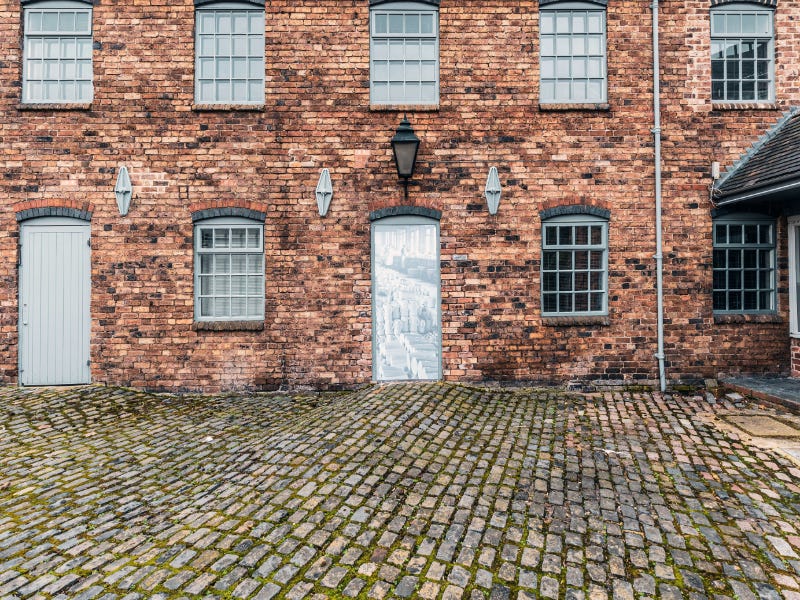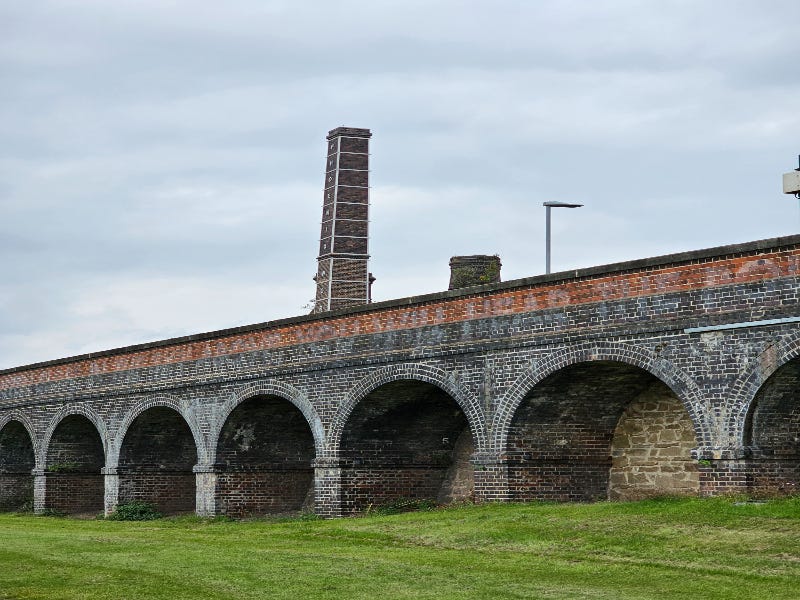Lights, Camera, Action: Why Filmmakers Should be Flocking to Stoke-on-Trent
Affordable, authentic and accessible, our city offers a versatile canvas for filmmakers, whether they're seeking pot banks and cobbles or grand historic houses

As a proud resident of Stoke-on-Trent, I’ve always felt this city doesn’t get the recognition it deserves, especially in film and television. With its rich industrial history, unique architecture, and incredible stories, Stoke-on-Trent has all the ingredients to be a filmmaker's dream. And yet, it remains underutilised in comparison to bigger, flashier cities like London, Manchester, or Birmingham.
Nevertheless, the city has made it onto the nation’s TV screens via The Great Pottery Throw Down, which is filmed at Middleport and more recently Gladstone, with the show’s judge, master potter Keith Brymer Jones telling our writer Hannah Hiles, “Filming in Stoke-on-Trent and in a place like Gladstone really adds credibility to the show. It's not just being filmed in a tent in a field somewhere.”
Having seen some brilliant productions filmed here over the years – Peaky Blinders, The Silent Child, and The Colour Room to name a few – I believe Stoke-on-Trent deserves more attention as a prime filming location. Let me tell you why.
1. Authenticity that reduces post-production work
One of the most striking things about Stoke-on-Trent is how authentic it feels. Our city’s heritage isn’t hidden behind modern facades – it’s on full display in every street, factory, and canal. This makes Stoke a perfect backdrop for historical dramas or period pieces.
Take Peaky Blinders as an example. When they filmed parts of season five at Middleport Pottery and along the Trent and Mersey Canal, there was no need for excessive set dressing or CGI to recreate the 1920s. The cobbled streets, industrial buildings, and canals provided the perfect setting, saving the production team time and money in post-production. Similarly, The Colour Room, which tells the story of ceramicist Clarice Cliff, benefitted from filming at real pottery sites like Middleport Pottery and the Gladstone Pottery Museum. The authenticity of these locations added depth to the story without the need for digital enhancements.
For filmmakers, this is a game-changer. Post-production can be one of the most expensive parts of making a film, and Stoke-on-Trent’s ready-made authenticity can drastically cut those costs.
2. A proven track record of successful productions
Over the years, several notable films and TV shows have been shot in Stoke-on-Trent, proving the city’s versatility and appeal:
Peaky Blinders: Middleport Pottery and the surrounding streets were used to create the gritty industrial setting of 1920s Birmingham.
The Silent Child: This Oscar-winning short film was shot in Longton Park and Caverswall, showcasing the city’s picturesque parks and suburban charm.
The Girl with All the Gifts: Hanley’s old bus station was transformed into a dystopian landscape for this Hollywood sci-fi thriller.
Doctor Who: Gladstone Pottery Museum served as the backdrop for parts of The Trial of a Time Lord in 1986.
The Colour Room: Stoke’s heritage sites brought to life the story of one of its most celebrated artists, Clarice Cliff.
Each of these productions highlights a different facet of Stoke-on-Trent, from its industrial roots to its green spaces and urban landscapes. It’s a city that can be anything you need it to be – Victorian England, a post-apocalyptic world, or a contemporary urban setting.
3. Cost-effective filming without compromising quality
Let’s face it: filming in big cities is expensive. London and Manchester may offer great locations, but they come with sky-high fees for permits, location rentals, and accommodation. Stoke-on-Trent, on the other hand, provides a more budget-friendly alternative without sacrificing quality.
Here’s how filmmakers can save money by choosing Stoke-on-Trent:
Lower location fees: Many of the city’s most iconic sites, such as Middleport Pottery and the Gladstone Pottery Museum, are managed by organisations keen to support filmmakers. Fees are far more reasonable compared to bigger cities.
Affordable accommodation and services: Housing cast and crew in Stoke-on-Trent is significantly cheaper than in London or Manchester. Local catering, transport, and other services also come at a fraction of the cost.
Minimal set dressing: As mentioned earlier, Stoke’s authentic locations often require little to no additional dressing, further reducing production costs.
For independent filmmakers or productions working with tight budgets, this can make all the difference.
4. Stoke-on-Trent at the heart of Staffordshire’s film future
Stoke-on-Trent’s potential as a filming location is amplified by the efforts of We Are Staffordshire, a partnership funded by Staffordshire County Council to raise the county’s profile, attract investment, and boost tourism. As part of this mission, the council has committed to a three-year pilot programme to establish Staffordshire Film Office, which is designed to attract national and international film and TV productions.
This new film office will showcase Staffordshire and Stoke-on-Tren as “open to film,” offering a single point of contact for production companies and highlighting the county’s impressive range of film-friendly locations. The office will work closely with Creative England and local councils to streamline the filming process, identify potential sites, and market the region as a cost-effective, film-friendly destination.
Stoke-on-Trent is poised to benefit greatly from this initiative. Already home to iconic filming locations like Middleport Pottery and the Gladstone Pottery Museum, the city is perfectly positioned to lead Staffordshire’s efforts in attracting productions. A thriving film office will not only bring more productions to the region but also raise Stoke-on-Trent’s profile on a national and global scale, boosting tourism, creating jobs, and showcasing the city’s unique charm.
With We Are Staffordshire championing this cause, Stoke-on-Trent has the support and resources to cement its place as a major player in the UK’s film industry.
5. Easy accessibility and infrastructure
Stoke-on-Trent’s central location makes it incredibly convenient for film crews. Whether you’re bringing in talent from London, Manchester, or Birmingham, the city is well-connected by train, road, and even air:
Train: Stoke is just 90 minutes from London Euston on the West Coast Main Line. It’s also well-connected to Manchester, Birmingham, and other major cities.
Road: Situated near the M6, Stoke-on-Trent is easily accessible by car, with plenty of parking for production vehicles.
Air: Manchester and Birmingham airports are both within an hour’s drive, making it easy for international crews to arrive.
In addition, Stoke-on-Trent has plenty of space to accommodate production teams. From dedicated parking areas at locations like Middleport Pottery to the city’s less congested streets, logistics here are far easier to manage than in larger urban centres.
6. A film-Friendly community
One of the things I love most about Stoke-on-Trent is its people. We’re a proud, passionate community that welcomes filmmakers with open arms. When Peaky Blinders was filmed here, locals turned out in droves to watch the action, thrilled to see their city on screen. Many volunteered as extras.
This enthusiasm extends to the local council, which actively encourages filmmakers to use Stoke-on-Trent as a location. The council offers assistance with permits, location scouting, and connecting with local businesses, making the process as smooth as possible.
7. A variety of film-friendly locations
Stoke-on-Trent is a city of contrasts, offering a wide range of settings within a compact area:
Industrial heritage: The city’s bottle ovens, canals, and factories are perfect for historical dramas and gritty urban stories.
Green spaces: Parks like Longton Park and Trentham Gardens provide lush, scenic backdrops.
Urban grit: Hanley’s streets and Stoke town centre deliver the urban edge needed for contemporary or dystopian narratives.
Rural charm: The surrounding Staffordshire Moorlands add a countryside feel to any production.
This diversity enables filmmakers to create multiple settings without the need to travel far, saving both time and money.
8. Why Stoke-on-Trent needs more spotlight
As someone who grew up in Stoke-on-Trent, it’s frustrating to see my city overlooked in favour of bigger, more expensive locations. We have everything a filmmaker could want: authenticity, affordability, accessibility, and a community ready to support the industry. More than that, we have stories – real, raw, and powerful stories – that deserve to be told.
Filmmakers, if you’re looking for a location that combines historic charm, modern convenience, and budget-friendly options, Stoke-on-Trent should be your first choice. Let our city be the canvas for your next masterpiece – you won’t be disappointed.
How to film in Stoke-on-Trent
If you’re considering Stoke-on-Trent for your next production, the city council is ready to help. They can assist with location scouting, permits, and connecting you with local resources. Contact them through their online portal to start planning your shoot.











Excellent article